What’s Happening Here?
Let’s start this week’s newsletter off with an end-of-season diagnostic challenge. This one is straightforward, so I went to Costco to get enough gold stars for everybody. Let’s see if I’m right. Here it is:
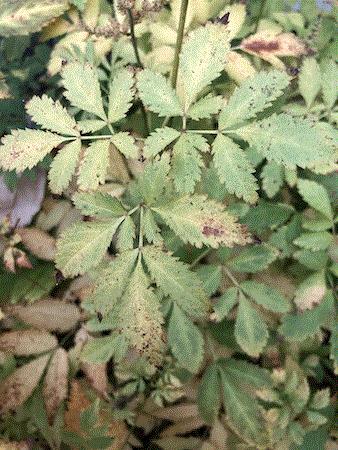
Astilbe
There honestly aren’t too many options for this one, but if you need a clue, I’ve already given it. Let’s see if you earned your golden star. It’s time for me to ask, "What’s happening here?"
"We use fungicides for bad cultural practices"
I was discussing disease management with a group of growers and I said, “We use fungicides for bad cultural practices, not because of diseases.” Then something incredible happened; the production manager turned to the growers in the room and asked them to repeat what I said. He asked them to repeat the phrase out loud two more times. It was one of those surreal moments.
Prior to saying this phrase, I was discussing how not only are greenhouses plant factories, they're also good disease factories. There are several reasons for this. Consider the plant densities inside many greenhouses, not to mention that they provide the ideal environmental conditions (temperature, humidity and foliage wetness) that diseases require for infection.
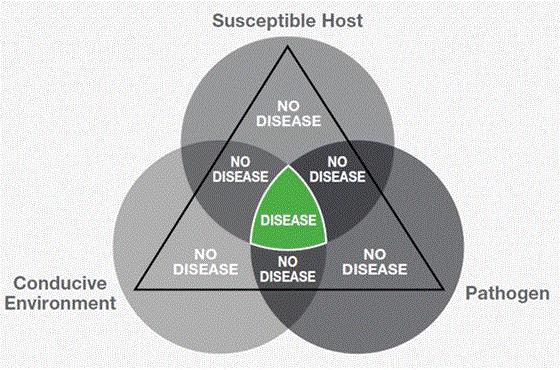
I also discussed the disease triangle—you know, the visual demonstration of a triangle that describes how each corner of the triangle (plant pathogen, susceptible host plant and suitable environmental conditions) has to be present for any disease to occur. In other words, diseases will only occur when interactions between the host plant, plant pathogen and environment are favorable.
While discussing this topic, I also found myself talking about how our cultural management practices contribute to the development of diseases. For example, many pathogens can infect plants when the foliage is wet for as little as four hours in some instances. I think you’d agree this occurs more often then we’d like to admit. If you’re truly honest with yourself, you’d also admit that many of your cultural practices greatly contribute to the development of diseases and the need to apply fungicides.
After giving a couple more examples, these words left my mouth, “We use fungicides for bad cultural practices, not because of diseases.” Now repeat this phrase out loud several times and think about the meaning behind these words. Then ask yourself, “How can my cultural practices be modified to reduce the development of diseases and the need to apply fungicides?”

Do you "DIG" the Virtual Reality of 2020?
2020 is definitely a year I can honestly say I’ll never forget. The main event of the year has undoubtedly been COVID-19, but there are so many other significant events that have made it one to remember. The year’s been chock-full of political drama that certainly won’t end with the election, “murder hornets” arrived in the U.S., we had the West Coast wildfires and protests and riots ... all are shaping this to be a year we’ll never forget.
It goes without saying that COVID-19 has changed how we live our personal and professional lives. Instead of face-to-face trade shows and educational meetings, many organizations are hosting online webinars and trade events. Here’s an upcoming virtual trade event I think you’ll "DIG."

AmericanHort is hosting its next online DIG (Disease, Insect & Growth Regulators) Conference November 3-5, 2020. Attendees of this virtual conference will experience in-depth education on disease, insect and growth regulator management. Here’s a sample of the educational sessions:
-
Building a PGR Program for Herbaceous Perennials (Joyce Latimer, Virginia Tech)
-
Make Sanitation Part of Your Culture (Rosa Raudales, University of Connecticut)
-
Biopesticides: Efficacy, Timing and Compatibility (Michael Brownbridge, BioWorks, Inc.)
-
Monsters Under the Bed(ding Plants): Root zone Pathogens (Janna Beckerman, Purdue University)
-
Insecticide Rotation in a Multi-Pest World (JC Chong, Clemson University)
-
Playing Whack-a-Mole with New Pests (Lance Osborne, University of Florida)
-
Finishing “Enhanced” Young Plants—from Transplant to Retail (Jamie Gibson, Syngenta Flowers)
This is just the tip of the iceberg, with 25 educational sessions in all, including several topics on managing insects and diseases on hemp. In addition to these great learning opportunities, DIG attendees will have the chance to network with industry professionals and engage in peer-to-peer activities during coffee chats, panel discussions and interactive roundtables.
If this sounds like an event you’ll "DIG," click HERE to learn more.

More Online Events
Proven Winners Landscape Roadshow
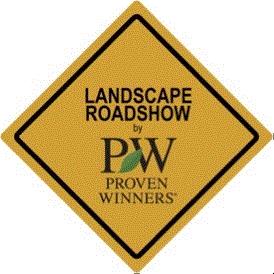
Proven Winners is hosting its virtual Landscape Roadshow on November 2, 4 and 6, 2020. Here’s a brief synopsis of the three-day event:
Monday, November 2 at 2:30 p.m. Eastern/1:30 Central
Join John Antonelli, Regional Sales Representative from Four Star Greenhouse, for his presentation titled, “Stunning New Proven Winners Annuals to Enhance Your Landscape.” Then Jane Beggs-Joles, Landscape Program Manager at Spring Meadow Nursery, takes us on a personal tour of Spring Meadow Nursery owners Dale and Liz Deppe’s private gardens in Grand Haven, Michigan.
Wednesday, November 4 at 2:30 p.m. Eastern/1:30 Central
Josh Roggenbuck, Regional Product Manager at Walters Gardens, kicks off the event, sharing the newest Proven Winners perennial selections that are ideal for landscape use. Next, Warren Gorowitz, Director of Corporate Social Responsibility at Hunter Industries, closes the day with his presentation titled “Smart Irrigation—Can technology make our jobs easier and improve our landscape?”
Friday, November 6 at 2:30 p.m. Eastern/1:30 Central
The three-day program concludes with a one-hour session titled, “Successful Landscape Design Using Proven Winners.” Leigh McGonagle, Proven Winners Certified Landscape Professional and owner of Poplar Point Studio in Monrovia, New York, shares her passion for plants at this interesting and informative session.
Professional CEU credits are available for ASLA and APLD members.
Click HERE for more information.
PPA: Virtual Edition

The Perennial Plant Association (PPA) is hosting a virtual event titled “The Grass Toolbox: Why the Pros Choose and Use.” The panelist of grass experts includes Mike Berkely of Growild, Inc.; Laura Ekasetya of Lurie Garden; and Donald Pell of Donald Pell Gardens. They'll discuss the grasses they like to work with, the best problem solvers, provide cautions and challenges, and provide predictions regarding which grasses they think will be in high demand.
Join the panel discussion on November 11, 2020 from 3:00 to 4:30 p.m. Eastern. There will be a happy hour following the panel discussion.
Click HERE for event info. (Note: There's a fee associated with these sessions.)
Northeast Greenhouse Conference Webinar Series
The Northeast Greenhouse Conference and Expo, sponsored by New England Floriculture Inc., is offering a six-part webinar series covering many relevant topics, including sanitation, pests, disease, biocontrols and PGRs. Beginning Wednesday, November 4, 2020 they'll be hosting a one-hour webinar each week through December 16, 2020 (there will be no webinar the week of Thanksgiving—you’ll have to enjoy some turkey instead). Pesticide recertification credits will be offered for the New England States and New York.
Click HERE for information on the Northeast Greenhouse Conference and Expo’s 2020 Virtual Webinar Series.

Award-Winning Perennials
Terra Nova’s done it again. Their new Centaurea Snowy Owl was the recipient of the “Best New Variety” award at Colorado State University’s (CSU) Fort Collins Annual Trial Gardens. This is the third year in a row a Terra Nova variety has received a “Best of” award at the CSU trials. In 2018, Artemisia Makana Silver won the Best Novelty, and in 2019, Begonia T Rex Ruby Slippers also won the Best Novelty award. Congrats to Terra Nova for continuing to bring some cool plants to the industry!
Snowy Owl has large velvety, white leaves that contrast beautifully with their surroundings. It grows to approximately 16- to 18-in. tall and across. Please forgive me for sharing this plant, which is only cold hardy to Zone 9. Unfortunately, it’s an annual for most of us, but I thought many subscribers would be interested in its potential as a component in mixed containers.
Agastache Morello
To make up for showing an annual, I thought I’d share one of my personal favorites from Terra Nova, Agastache Morello. Morello is not a new introduction, but has performed very well in trials across the country and received several notable awards in 2017, including a Top 10 award at the University of Georgia perennial trials, "Best of Variety" award at Penn State trials (rated 4.8 out of 5) and #4 of the top pollinators at Ohio State University trials.
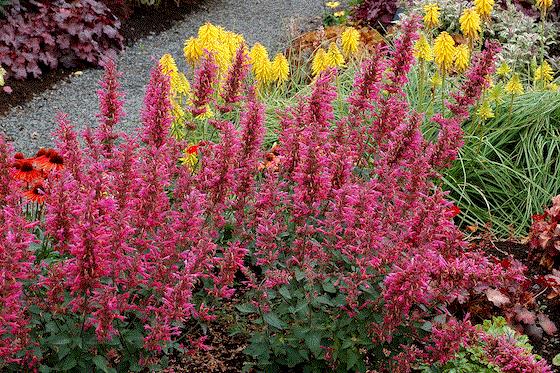
Agastache Morello has tons of flower power, a great plant habit and very large, deep burgundy flowers. With a height of 27 to 33 in., this showy agastache is slightly larger than many of the recent introductions to hit the market, but it stands up well and is definitely worth considering. Hardy to Zone 5.

The Answer is …
At the top of the newsletter, I asked you to participate in this week’s diagnostic challenge. I shared this image of an astilbe I recently came across:
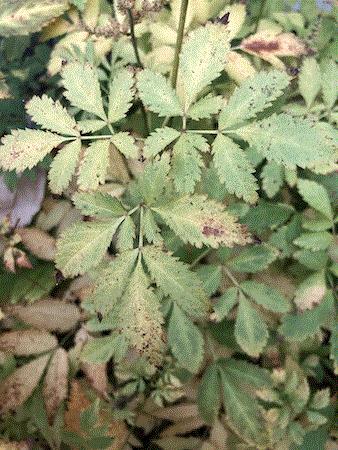
I was thinking it would be an easy challenge, however, I can see that there could be a few possibilities. Did you pick the right one?
If you answered, "There's nothing wrong with the astilbe," you earned yourself a gold star. If you don’t believe me, consider the hidden clue I provided in the opening sentence of the newsletter: "end-of-season diagnostic challenge."
That’s right, I was a little tricky on this one; this is the normal fall appearance of an astilbe as it transitions into its dormant phase for the winter.
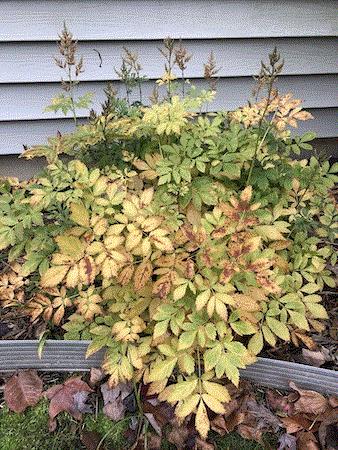
It can be difficult to evaluate plant health in the fall, as many perennials will change colors. Although they may appear malnourished or appear to be experiencing a major cultural issue, they're perfectly healthy for this phase of their life cycle. I really hope you didn’t "fall" victim to this week’s tricky challenge.




Thanks for reading this edition of Perennial Pulse. My email is ppilon@ballpublishing.com if you have any comments or suggestions.
Take care,
Paul Pilon
Editor-at-Large - Perennial Pulse
Perennial Consultant - Perennial Solutions Consulting
This email was received by you and 30,743 other fine subscribers!
If you're interested in advertising in Perennial Pulse, contact Kim Brown ASAP and she'll hook you up.